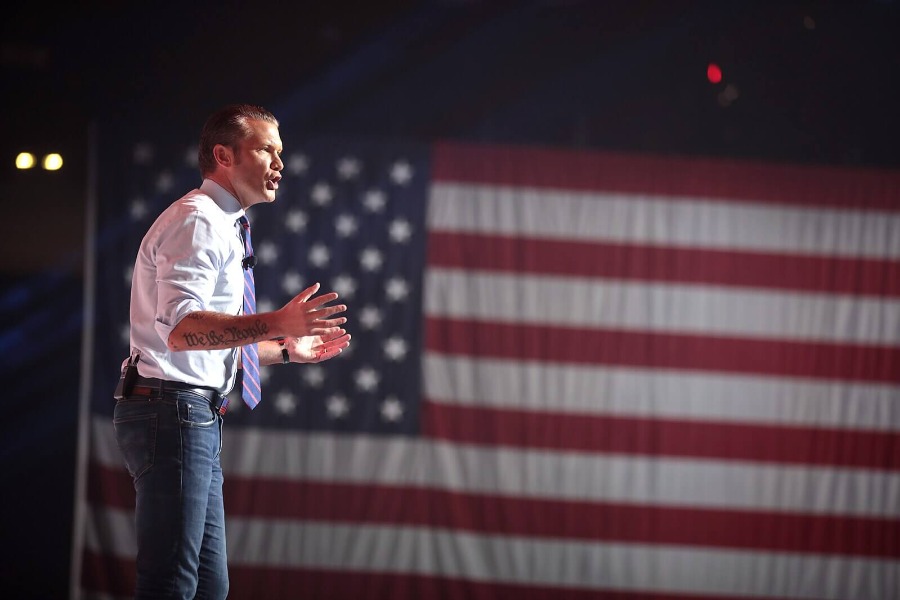How the Ninth Circuit Did It: Due Process Sinkhole Swallows Trump’s Executive Order Whole
Last week, U.S. District Judge James Robart (a George W. Bush appointee) sent President Trump into a Twitter tizzy by issuing a temporary restraining order (TRO) enjoining the enforcement of Trump’s immigration executive order.
Published by The Lawfare Institute
in Cooperation With

Last week, U.S. District Judge James Robart (a George W. Bush appointee) sent President Trump into a Twitter tizzy by issuing a temporary restraining order (TRO) enjoining the enforcement of Trump’s immigration executive order. Yesterday, a three-judge panel of the Ninth Circuit issued a per curiam opinion denying the government’s motion to stay the TRO.
In a quick reaction piece last night, Ben critiqued the decision for failing to even mention 8 U.S.C. § 1182(f), the statutory basis for Trump’s executive order. (Apparently, Trump was also personally bothered by this failure.) That’s the provision of the Immigration and Nationality Act (INA) that gives the president sweeping authority to suspend or restrict, “by proclamation, and for such period as he shall deem necessary,” the entry of all aliens or any class of aliens into the United States whenever he “finds that the entry . . . would be detrimental to the interests of the United States.”
Ben’s right; it was strange to leave out the citation, given it is the crux of the government’s argument for the president’s unbridled discretion to bar aliens from the country. But after reviewing the opinion and the parties’ filings, I don’t think the court's omission of the citation was accidental or that its omission of a § 1182(f) discussion is surprising. This is a clever, if undisciplined, opinion that sought to get to its holding (denial of the stay) without tripping legal landmines or weighing in on big unresolved questions. The court ignored the elephant in the room—the statutory and constitutional powers conundrum—in favor of a two-step dance: (1) a high-level defense of the judicial power to review executive decisions, including in the national security arena, and (2) an in-the-weeds approach to applying the traditional stay factors—one that opts against a macro-analysis of the government’s likelihood to prevail on the constitutional powers question and relies instead on a superficial micro-analysis of the persuasiveness of the government’s case in overcoming allegations of individual constitutional rights violations (effectively adopting the approach of States Washington and Minnesota in their brief (pp. 14-20)).
Note there is squishiness here about the right way to analyze the stay factors in part because the parties to the suit are states and not individuals. (Consider: what does it mean, exactly, for the government to be "likely to be successful on the merits" vis-à-vis not particular individuals with a particular immigration status who are challenging the lawfulness of the ban as applied to their case but rather a state asserting the rights and interests of so many differently situated individuals?)
1. The high-level discussion comes first. This whole portion of the court’s analysis amounts to a loud statement of separation-of-powers first principles and didn’t require the court to discuss § 1182(f) or a do a deep dive into the nuances of the president’s Article II powers. The court stayed far away from blockbuster problems like how to reconcile § 1182(f)’s sweeping grant of executive discretion with the anti-discrimination provision of 8 U.S.C. § 1152(a)(1)(A), which provides that “no person shall receive any preference or priority or be discriminated against in the issuance of an immigrant visa because of race, nationality, place of birth, or place of residence.” Sticking instead to low-hanging fruit, the court rejected the more extreme assertions of executive authority that the government built on top of § 1182(f), i.e., that the president has “complete discretion” and “unreviewable” power to exclude aliens from the U.S. (pp. 2, 15). Thanks to the government's failure to present any factual evidence to supports its argument for the national security objectives of the executive order, the court was able to do this with little more than pointed, attention-grabbing citations to major cases attesting to the judiciary’s role in checking the political branches: Boumediene v. Bush, 553 U.S. 723 (2008), Holder v. Humanitarian Law Project, 561 U.S. 1 (2010), Ex parte Milligan, 71 U.S. 2 (1866), and so on.
2. So emphatically, if abstractly, the court made out its principled defense of the judiciary’s power to review executive decision-making as a general matter. Check. The meat of the Ninth Circuit’s approach after that—its analysis of the stay factors—really boils down to the technical choices reflected in this paragraph:
The Government has not shown that it is likely to succeed on appeal on its arguments about, at least, the States’ Due Process Clause claim, and we also note the serious nature of the allegations the States have raised with respect to their religious discrimination claims. We express no view as to any of the States’ other claims. (emphasis added, p.19).
You can start to see from this description why the States ultimately prevailed against the stay. Think about what the court could have done instead. The court could have centered its examination of the likelihood-of-success-on-the-merits prong on how broadly the president’s authority under § 1182(f) and Article II sweeps and how the contours of that authority must be determined—and thus how powerful a case the government made that Judge Robarts got this big question wrong. But instead, the court adopted the States’ limited, piecemeal focus on the persuasiveness of the government's case in overcoming arguments about the individual constitutional rights allegedly violated. The court asked: did the government carry its burden of making “a strong showing that [it] is likely to prevail against the States’ due process claims” (p. 20, emphasis added)? Notice that parsing the question like this, and assessing the persuasiveness of the government's arguments as to each alleged violation (due process, along with equal protection and establishment clause), is quite different from asking whether the government made the required showing of likelihood of success on the merits of the case. See Nken v. Holder, 556 U.S. 418, 426 (2009). The former is by design somewhat myopic (and potentially confusing because we're talking about a lot of differently situated people); the latter would seem to require some bird's-eye consideration of just how far the president's immigration powers extend.
The Ninth Circuit confined its ruling further by choosing to answer the question only as to the due process claim. Again, this appears to have been a conscious choice, on several levels. The court didn’t charge headlong into the constitutional issue on everybody’s brain and in the political headlines all last week: the issue of whether this order was intended as a “Muslim Ban” and whether Trump and his team team gave the game away with their comments to that effect. Despite some solemn observations about the facts alleged on this score, the court refused to actually pass judgment on that issue. Instead, it hung most of the opinion on due process, which appears to be the least politically fraught constitutional claim. And the court focused this analysis on the people who indisputably have, by the Administration’s own concessions, the strongest due process claim: the lawful permanent residents (LPRs) affected by the executive order.
The decision goes more rapidly downhill for the government from here. Why? The government’s arguments indicate it hoped the Ninth Circuit would at least save what it could of the executive order from the TRO—that is, sever what doesn’t work from what does. The Ninth Circuit, however, did precisely the opposite. By my read, the panel treated the LPR due process problem like a sinkhole, one that swallows almost everything else and ultimately kills the government’s requested stay.
Here is how the court’s sinkhole reasoning ends up working:
-
Obviously, LPRs have constitutional due process rights and the executive order affects them.
-
The administration's attempt to put a last-minute band-aid on the LPR-exclusion problem fails; specifically, White House counsel Donald McGahn's after-the-fact “guidance” deeming the order inapplicable to LPRs is legally meaningless.
-
The TRO holds up even to the extent it covers people other than LPRs; the line between those who enjoy due process rights and those who do not isn't strictly an LPR demarcation (e.g., what about the rights of U.S. citizens with an interest in ensuring their alien spouses can enter?).
-
To the extent the TRO extends geographically beyond Washington and Minnesota, the court won’t restrict its effect. That’s because the government hasn't proposed "a workable alternative form of the TRO" that would allow it to limit the geographic scope in a way that makes sense given “the nation’s multiple ports of entry and interconnected transit system” and “the proprietary interests of the States at issue here.” The subtext: the executive order itself made no attempt to distinguish the rights of the various individuals and the government is not getting a laborious carve-out effort from the court. If the order doesn’t bother drawing the lines, then the court is not willing to do the administration’s job for it. The government made its bed with an ambitious order that doesn’t trouble with distinctions, and now it must lie in it.
-
The court’s refusal to carve out or sever anything means that, for purposes of the stay analysis, the whole order gets sucked into the LPR due process sinkhole.
It's interesting to consider how the Ninth Circuit's approach could influence how executive orders are thought about and fought in the courts going forward.
In particular, it strikes me as significant that the Ninth Circuit resisted modifying the district court’s TRO to save portions of the underlying executive order pending appeal. For one thing, if other appellate courts decide to take a similar approach, that would allow the district courts quite a bit of power to shape the trajectory of the litigation. For another thing, the Ninth Circuit’s refusal to “fix” the TRO based on the practical complications involved functions as a commentary on the hasty, overinclusive nature of the underlying order itself. By refusing to modify the reach of the district court’s restraining order, the Ninth Circuit is, in a crucial sense, refusing to incentivize this kind of drafting practice from the executive branch in the future—drafting that, perhaps in the court’s view, errs on the side of maximum reach, maximum mess, and maximum collateral damage, and should not be rewarded.





